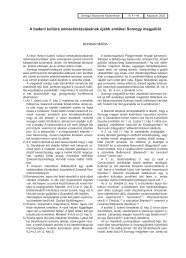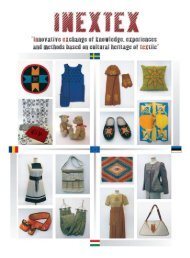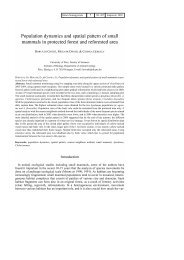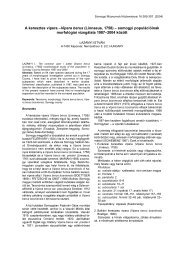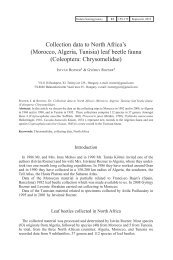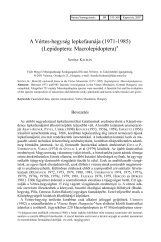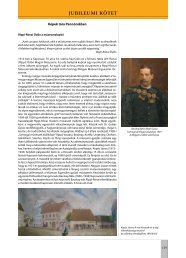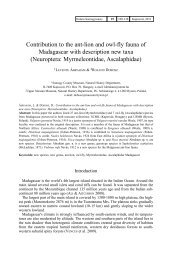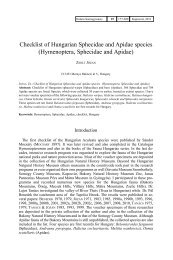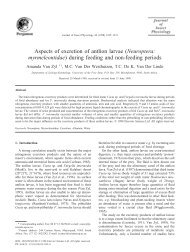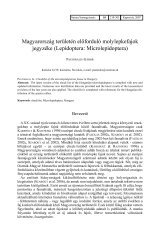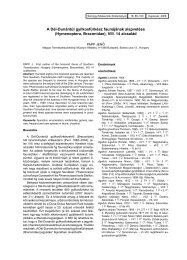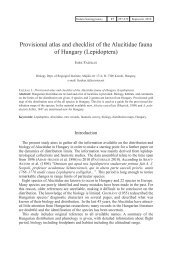Study on the Palaearctic Pristiphora species (Hymenoptera ...
Study on the Palaearctic Pristiphora species (Hymenoptera ...
Study on the Palaearctic Pristiphora species (Hymenoptera ...
You also want an ePaper? Increase the reach of your titles
YUMPU automatically turns print PDFs into web optimized ePapers that Google loves.
HARIS A.: STUDY ON THE PALAEARCTIC PRISTIPHORA SPECIES<br />
243<br />
Although I have not seen <strong>the</strong> type of P. harai Togashi, however, <strong>the</strong> descripti<strong>on</strong> and<br />
<strong>the</strong> figures perfectly match to <strong>the</strong> type of P. politivaginata (Takeuchi), Fig. 200. Fur<strong>the</strong>r<br />
investigati<strong>on</strong> and evidences are necessary. Togashi did not menti<strong>on</strong>ed P. politivaginata<br />
in his differential diagnosis.<br />
<strong>Pristiphora</strong> bifida (Hellén, 1947) and <strong>Pristiphora</strong> salicivora (Takeuchi, 1922)<br />
Type checked: Lygae<strong>on</strong>ematus salicivorus Takeuchi, 1922: Lectotype (Takeuchi <strong>on</strong>ly wrote in his original<br />
label: Type), female: 20. 09. 1920, Katayama, leg.: Takeuchi.<br />
I could not differentiate <strong>the</strong>se 2 <strong>species</strong> by external morphology. Genitalia dissecti<strong>on</strong><br />
is necessary. All <strong>the</strong> same, <strong>the</strong> geographical separati<strong>on</strong> is very helpful to identify <strong>the</strong> 2<br />
<strong>species</strong> (if <strong>the</strong>y are really 2 <strong>species</strong>).<br />
<strong>Pristiphora</strong> staudingeri (Ru<strong>the</strong>, 1859), <strong>Pristiphora</strong> hyperborea Malaise, 1921 and<br />
<strong>Pristiphora</strong> astragali Vikberg, 1978<br />
Three closely related <strong>species</strong>. Differential diagnosis is given after Vikberg, 1978:<br />
1. Pterostigma darker than <strong>the</strong> swollen apical part of costa. Coriaceous microsculptur<br />
<strong>on</strong> lower half of mesepisternum weaker, so that <strong>the</strong> surface looks more or less shiny.<br />
.........................................................................................................P. astragali Vikberg<br />
- Stigma and apical part of costa ra<strong>the</strong>r pale. Lower half of mesepisternum dull.......2.<br />
2. Microsculpture <strong>on</strong> <strong>the</strong> lower upper half of mesepisternum and <strong>on</strong> <strong>the</strong> mesoscutum<br />
and mesoscutellum str<strong>on</strong>g. Saw with lateral setae (bristles) <strong>on</strong> sutures (segments) 3-15.<br />
Tangium (stem of <strong>the</strong> saw) somehow with blunt basal corner.......P. hyperborea Malaise<br />
- The microsculpture <strong>on</strong> <strong>the</strong> above menti<strong>on</strong>ed parts not so str<strong>on</strong>g (however definitely<br />
not shiny). Saw with lateral setae (bristles) <strong>on</strong> sutures (segments) 4-12. Tangium with<br />
acute basal corner............................................................................P. staudingeri (Ru<strong>the</strong>)<br />
<strong>Pristiphora</strong> chromata Rohwer, 1910<br />
The type (deposited in <strong>the</strong> USNM) checked by Dr. Smith for my request. According<br />
to his opini<strong>on</strong>: "<strong>Pristiphora</strong> chromata Rohwer is not a <strong>Pristiphora</strong> at all, it is a Nematus. It has an emarginated<br />
clypeus, l<strong>on</strong>g inner tooth <strong>on</strong> <strong>the</strong> tarsal claws (but not as l<strong>on</strong>g as <strong>the</strong> outer tooth), costa not swollen near<br />
stigma, and a ra<strong>the</strong>r slender sheath (no scopa at apex).".<br />
<strong>Pristiphora</strong> pusilla Malaise, 1921 and <strong>Pristiphora</strong> amaura Lindqvist, 1955<br />
According to Savela 2005, P. amaura Lindqvist is a junior syn<strong>on</strong>ym of P. pusilla. In<br />
<strong>the</strong> key of Zhelochovtsev, 1988 <strong>the</strong> two <strong>species</strong> has completely different penis valve,<br />
compare Figs. 114 and 118.<br />
<strong>Pristiphora</strong> dochmocera (C. G. Thoms<strong>on</strong>, 1871) and <strong>Pristiphora</strong> araratensis sp. n.<br />
Haris (2003) reported P. dochmocera (Thoms<strong>on</strong>) from Turkey, Ararat Mts. However,<br />
it was a misidentificati<strong>on</strong>. This specimen is <strong>the</strong> holotype of P. araratensis sp. n.<br />
Prisitphora list<strong>on</strong>i Lacourt, 1998<br />
Types checked: Holotype: male: St. Vézan, (05) 2400 m, 13. vii. 85, J. Lacourt, <strong>Pristiphora</strong> list<strong>on</strong>i male, J.<br />
Lacourt det, and Paratype, female: St. Vézan, (05) 2400 m, 13. vii. 85, J. Lacourt, <strong>Pristiphora</strong> list<strong>on</strong>i female,<br />
J. Lacourt det. Valid <strong>species</strong>.<br />
Male. Body entirely black including tegula, mouthparts (except apex of mandible) and<br />
antenna. Legs: femora black, apices of fore and middle femora light brown, tibiae and<br />
tarsi light brown but apical third of hind tibia and hind tarsus dark blackish brown, infuscate.<br />
Cenchri greyish white. Wings hyaline, stigma, costa transparent light brown.



